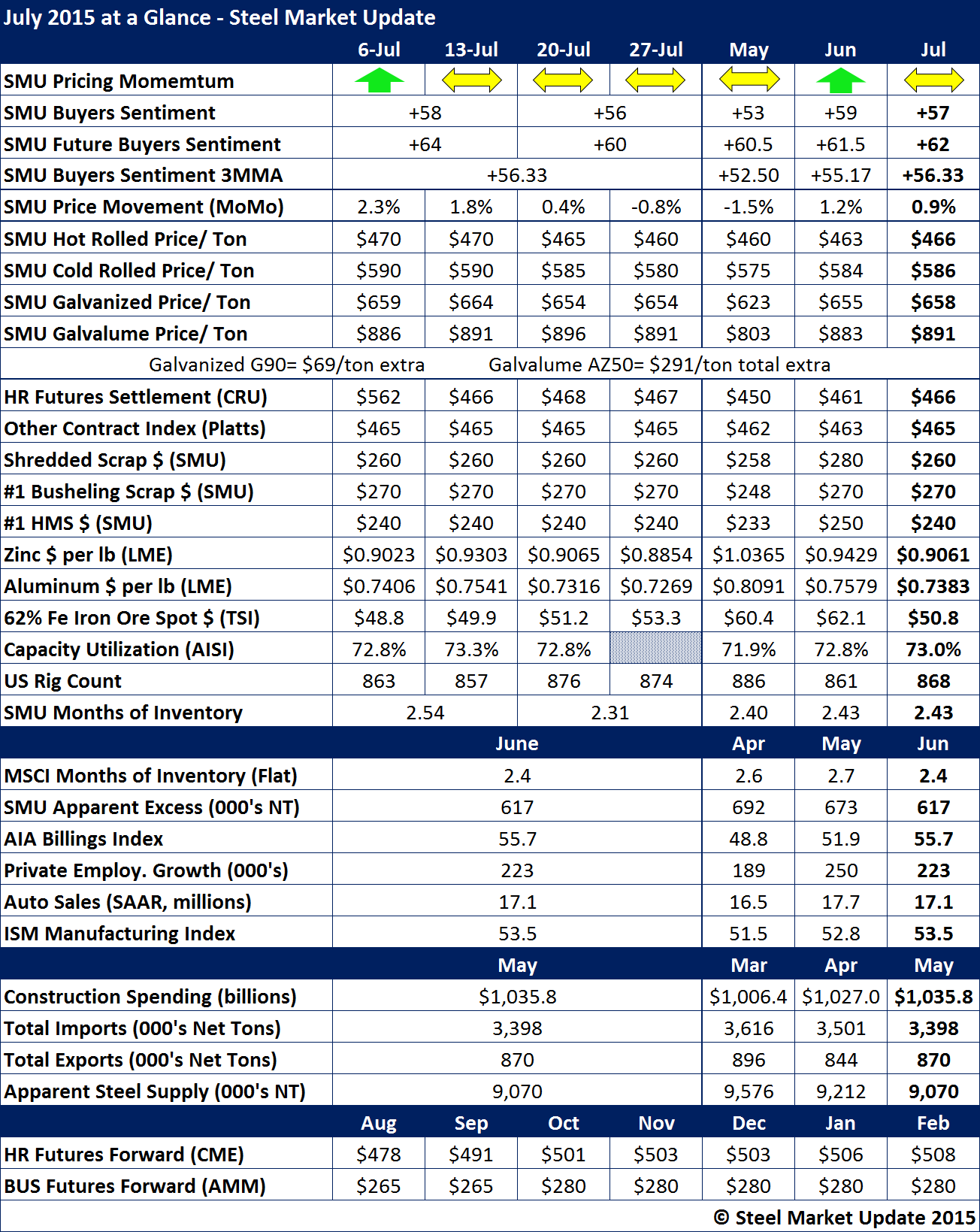SMU Data and Models

July Steel Data at a Glance
Written by John Packard
August 2, 2015
Flat rolled steel prices, and the momentum associated with steel price movement, have been stuck for quite some time as you can see by our SMU Price Momentum at the top of the table below. As a result, our benchmark hot rolled price average is $3 per ton higher than what we reported at the end of June and $6 per ton higher than that of May.
As you can see, the other two indexes watched closely by the steel community (CRU and Platts) were within one dollar ($1) of the SMU average for the month.
You can also see by our weekly numbers that hot rolled coil prices have been slipping as of late. This is due to an expansion of the range. We are expecting the domestic steel mills to file antidumping and countervailing duty cases on hot rolled during the month of August. We will see if the combination of HR, CR and coated trade cases begins to impact pricing.
SMU Steel Buyers Sentiment Index 3 month moving average (3MMA) has been improving. We believe this is due to a strengthening of the commercial construction sector and would be even better if the energy markets were to rebound.
Zinc and aluminum prices are both lower as of the end of the month. Iron ore prices are also down.
MSCI months on hand (flat rolled) dropped to 2.4 months as of the end of June. However, SMU Service Center Apparent Inventory Excess was calculated to be 617,000 net tons (our forecast is calling for tonnage to drop significantly over the next two months – if you want to learn more inquire about becoming a Premium level subscriber to SMU).
Imports are down but are still well above the 3.0 million net ton mark. Apparent steel supply continued to drop.

John Packard
Read more from John PackardLatest in SMU Data and Models

SMU Scrap Survey: Sentiment Indices rise
Both current and future scrap sentiment jumped this month, though survey participants reported responses before key trade news was announced.

SMU Survey: Sentiment splits, buyers have better view of future than the present
SMU’s Steel Buyers’ Sentiment Indices moved in opposite directions this week. After rebounding from a near five-year low in late June, Current Sentiment slipped again. At the same time, Future Sentiment climbed to a four-month high. Both indices continue to show optimism among buyers about their company’s chances for success, but suggest there is less confidence in that optimism than earlier in the year.

SMU scrap market survey results now available
SMU’s ferrous scrap market survey results are now available on our website to all premium members. After logging in at steelmarketupdate.com, visit the pricing and analysis tab and look under the “survey results” section for “ferrous scrap survey” results. Past scrap survey results are also available under that selection. If you need help accessing the survey results […]

SMU flat-rolled market survey results now available
SMU’s latest steel buyers market survey results are now available on our website to all premium members. After logging in at steelmarketupdate.com, visit the pricing and analysis tab and look under the “survey results” section for “latest survey results.” Past survey results are also available under that selection. If you need help accessing the survey results, or if […]

SMU Survey: Sheet lead times stabilize, plate contracts
Mill lead times for sheet products were steady to slightly longer this week compared to our late June market check, while plate lead times contracted, according to steel buyers responding to this week’s market survey.

